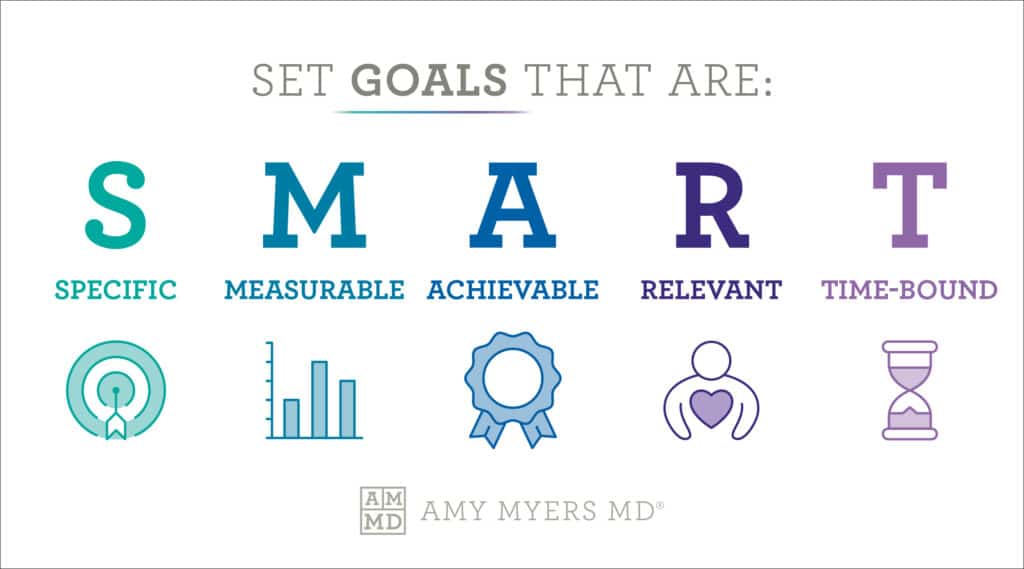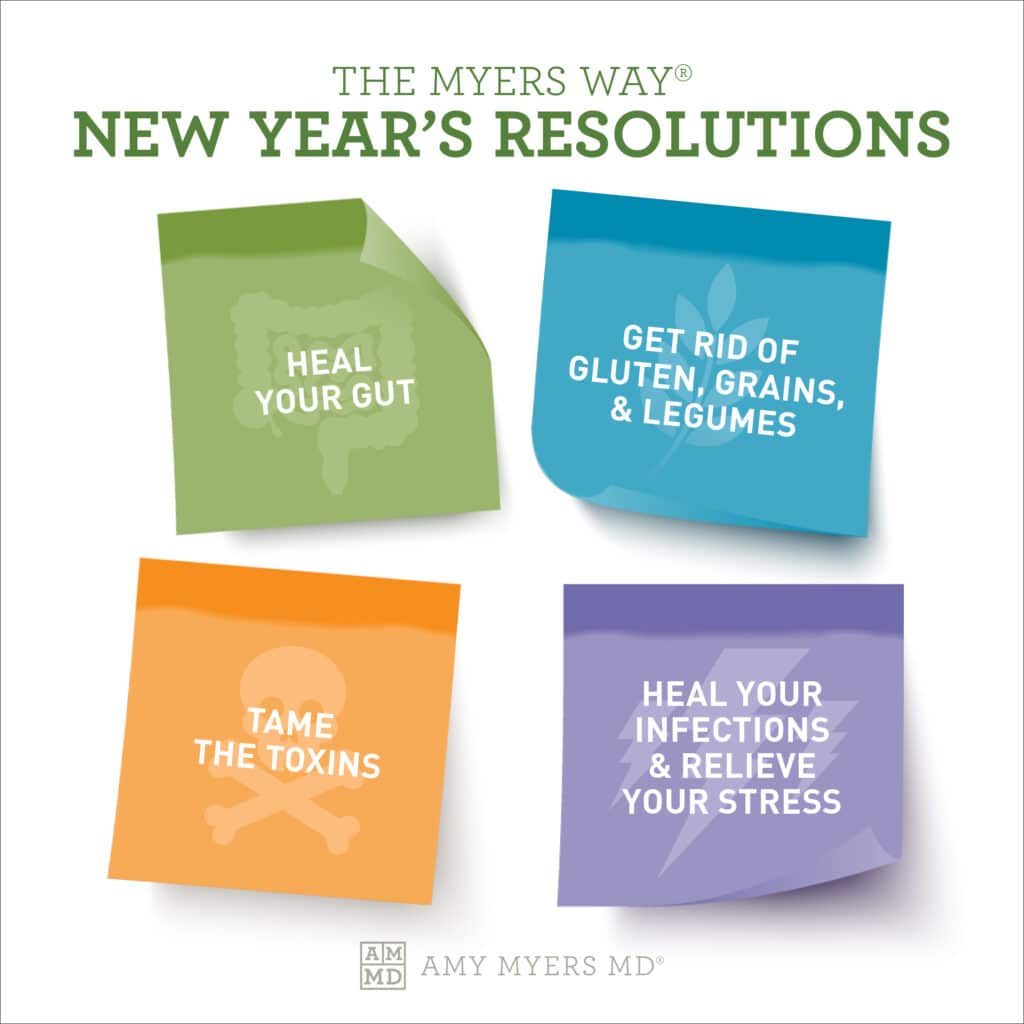I get it. Starting a new habit can be very challenging. You set nutrition goals with the best of intentions, and you get off track three or four weeks later. Or, in some cases, the start date gets pushed back so many times (think.. I’ll start on Monday!) that, eventually, you give up. You’re not alone in struggling to stay on track, especially this time of year. The empowering part is that getting back on track with your nutrition goals is always possible. There is no start time – it’s a lifelong journey.
It’s essential not to be too hard on yourself. Remember that nobody is perfect. It’s okay to have a slip-up from time to time. The empowering part is that you can get back on track. Here are some tips to get your nutrition goals on the right path.
Nutrition Goal Dos and Don’ts
So many of you set nutrition goals to eat healthier at the beginning of the year. If you got off course with your goals, I have good news: It’s still possible to restart! Here are some dos and don’ts to put you back on track with your nutrition goals.
Nutrition Goals Don’ts
1. Don’t Put It Off
There’s a saying, “don’t put off until tomorrow what you can do today.” The same way of thinking applies to your nutrition goals. No written rule says nutrition goals begin on a Sunday or the first of the month. Make your very next meal a healthy one. This Stuffed Avocados with Cilantro Cream Sauce recipe is delicious, AIP-approved, and full of healthy vegetables, protein, and flavors.
2. Don’t Be Hard on Yourself
If you’ve eaten a high-calorie dinner or had one too many pieces of cake, it’s not the end of the world, and it’s important to remember that everything is ok in moderation. As I mentioned, this is a journey and you can focus on your next decision instead of dwelling on the past.
3. Don’t Be Extreme Trying to Make Up for a Slip
Remember the big picture and the reason you set nutrition goals in the first place. You will likely have regular slips if your nutrition goals are too extreme. Set sustainable nutrition goals by eating fresh whole foods. I will tell you how to do that in just a minute. Now, let’s discuss what you should do.
Nutrition Goal Do’s
1. Set SMART Goals
The best way to create sustainable nutrition goals is to plan SMART goals. Here’s what I mean:
- Specific: Ensure that your goal is straightforward to help you stay focused.
- Measurable: Having a measurable goal will help you see your progress and encourage you to catch up or keep going.
- Achievable: Make sure your goals are achievable, don’t set unrealistic expectations for yourself that you know are out of reach.
- Relevant: Keeping relevant goals also helps you keep your eye on the prize and stay on course.
- Time-Bound: Giving yourself a “deadline” for your goal gives you a definitive finish line and encourages you to keep it up until the end.
 Dr. Amy Myers
January 31st, 2023
https://content.amymyersmd.com/article/nutrition-goals/Nutrition goals – infographic – Amy Myers MD®
Dr. Amy Myers
January 31st, 2023
https://content.amymyersmd.com/article/nutrition-goals/Nutrition goals – infographic – Amy Myers MD®2. Drink Plenty of Water
Water is necessary for all of your body’s processes, including cell repair, digestion, and nutrient absorption. Your body is 60% water, which becomes depleted as your body uses it for its processes. So, how much should you drink every day?
Aim to drink between half an ounce to an ounce of water for each pound you weigh. For example, if you weigh 150 pounds, you should aim for 75 to 150 ounces of water each day.
The type of water you drink is also essential. I recommend drinking filtered water due to the number of heavy metals and contaminants in our modern water supply. I have a full-house filtration system from Aquasana in my Santa Fe, New Mexico home.
You should also avoid drinking water from plastic bottles to avoid toxins such as Bisphenol A (BPA), which can imitate estrogen and other hormones. I prefer to drink out of glass or stainless steel.
3. Get Active
Regular exercise does more than tone your muscles and improve your heart health. Staying active can influence your food choices as well.
One study found that 30 minutes of daily exercise influenced people to choose healthier foods after working out.1 They chose more fruits, vegetables, and healthy snacks than those who didn’t.
You don’t need to have a strenuous workout. Regular exercise for just 30 minutes a day can lower your stress and boost your mood, and it also promotes optimal sleep and strengthens your immune system.
Online physical fitness options include bodyweight exercises, cardio, yoga, and Pilates classes. Even better, a lot of them are free. You can even start getting active by simply taking a walk outside! I love taking walks with my family. Dancing around your house is another excellent way to get your body moving.
4. Recommit to The Myers Way®
If you’ve lost track of your nutrition goals, get back on board with The Myers Way®. The Myers Way® is not so much of a diet; think of it as a way of life. I will tell you more about this proven method in just a minute and about some exciting new delicious snacks.
To get back on track with your nutrition goals:
- Begin by removing toxic and inflammatory foods.
- Focus on a diet with nutrient-dense whole foods.
- Include a lot of organic fruits and vegetables, grass-fed meat, and wild-caught fish.
And when you do want to indulge, choose natural, autoimmune-friendly options such as these Gluten-Free Vanilla Cupcakes.
Now that you know the dos and don’ts for getting your nutrition goals back on track let me tell you more about The Myers Way®.
The Myers Way® & Nutrition Goals
The Myers Way® gets to the root cause of your symptoms and is rooted in functional medicine. I have used this approach on thousands of patients and have seen amazing results. This functional medicine approach rests on four pillars to get to the root cause of your symptoms so you can achieve optimal health.
 Dr. Amy Myers
January 31st, 2023
https://content.amymyersmd.com/article/nutrition-goals/Nutrition goals – infographic – Amy Myers MD®
Dr. Amy Myers
January 31st, 2023
https://content.amymyersmd.com/article/nutrition-goals/Nutrition goals – infographic – Amy Myers MD®Pillar I: Heal Your Gut
To begin, you have to heal your gut. Your gut is the foundation of your health. You cannot have a healthy immune system without a healthy gut because 80% of your immune system resides in your gut. To heal your gut, use the 4R approach:
- Remove the bad: Get rid of factors that negatively affect the environment of the GI tract. This includes inflammatory and toxic foods and gut infections such as Candida overgrowth and Small Intestinal Bacterial Overgrowth (SIBO).
- Restore what’s missing: Add digestive enzymes to support optimal digestion and nutrient absorption.
- Reinoculate healthy bacteria: Taking probiotics can help restore beneficial bacteria to reestablish a healthy balance of bacteria to heal your gut.
- Repair the gut: provide nutrients necessary to help repair your gut. Leaky Gut Revive® is my No. 1 tool to fix a leaky gut.
Pillar II: Get Rid of Gluten, Grains, and Legumes
Once you heal your gut, it’s time to address your diet and lifestyle. One of the best ways to get your nutrition goals back on track is to eliminate foods that cause inflammation and damage your intestinal tract: gluten, grains, and legumes.
Gluten is a protein found in many grains, including wheat, rye, and barley – the common ingredients in bread. It’s what gives bread its sticky, doughy texture. Gluten can lead to intestinal permeability, otherwise known as leaky gut.
In sensitive people, gluten can cause the gut cells to release zonulin, a protein that can break tight junctions apart. Once these tight junctions get broken apart, you have a leaky gut. When your gut is leaky, toxins, microbes, and undigested food particles — among other things — escape from your intestines. From there, they travel throughout your body via your bloodstream.
Grains and legumes contain similar proteins that contribute to a leaky gut by damaging cells in your gut lining, opening the tight injunctions in your gut, and feeding unhealthy bacteria to create dysbiosis.2
Pillar III: Tame the Toxins
Pillar III addresses and reduces your body’s toxin exposure, including heavy metals such as lead, mercury, cadmium, industrial chemicals and pollutants, and pesticides. I mentioned the need to drink filtered water.
Unfortunately, toxins are also in everyday products such as home cleaning products, clothing, skincare products, and even your makeup. Each exposure to toxins adds to your body’s toxic burden. Think of your body as a cup; toxins are drops of water, and those additional small cumulative toxic exposures will cause that cup to overflow. The overexposure to toxins keeps your immune system on high alert, and it begins to misfire and attack everything in sight, including healthy cells and tissues.
The best action you take to lighten your toxic burden is to prevent the toxins from getting into your system from the start. You can support this by drinking clean water, buying clean food, and toxin-free body products.
Pillar IV: Heal Your Infections and Relieve Your Stress
An autoimmune disease develops from that chronic state of inflammation. When a patient isn’t getting better on the first few pillars of The Myers Way®, I consider the possibility of an underlying infection. Once you have a virus, the inflammatory immune response damages tissue, which then causes more inflammation and a more robust response from the immune system.
Addressing your infections and relieving your stress are crucial steps to get your immune system functioning optimally. Adopting daily stress-relieving strategies, such as exercise, dance, and meditation, will help give your immune system a boost.
Additional Support for Your Nutrition Goals
Once you’ve been following The Myers Way®, you’ll realize that it’s not willpower that keeps you going. Following the Myers Way® will truly transform your way of life. Even so, as with any diet or nutrition goals, you need additional support from time to time.
To support your nutrition goals, I recommend adding a high-quality multivitamin to ensure you get optimal amounts of vital nutrients for optimal health.
I specially formulated my The Myers Way® Multivitamin to contain the highest quality blend of vitamins and minerals designed for optimal absorption and bioavailability.
While you’re out and about, having healthy, nutritious (and yummy) snacks is always great. I usually make a smoothie with my Paleo Protein and bring it with me on the go. A smoothie is great for satisfying your hunger between meals and is loaded with protein to keep you feeling full and energized throughout the day.
The Final Word on Nutrition Goals
Getting back on track with your nutrition goals can seem like an uphill battle. However, it’s really simple. Remember why you set nutrition goals and start with your next meal. Be sure to incorporate movement and water as you return to your nutrition goals. I’m here for you if you need a little encouragement!
Article Sources
- How Exercise Can Influence What We Eat — and How Much. Brian Mastroianni. Healthline. 2021.
- Effect of primary processing of cereals and legumes on its nutritional quality: A comprehensive review. Morteza Oghbaei and Jamuna Prakash. Cogent Food & Agriculture. 2016.
